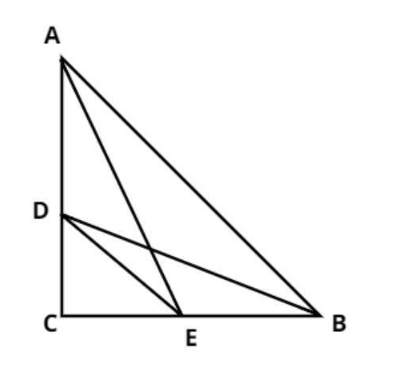
D and E are points on the sides CA and CB respectively of a triangle ABC right angled at C.
Prove that: $A{E^2} + B{D^2} = A{B^2} + D{E^2}$
Answer
611.1k+ views
Hint: Apply Pythagoras theorem here while solving.
Pictorial representation of the given problem is shown below.

Two points D and E are on the sides AC and AB.
We have to prove $A{E^2} + B{D^2} = A{B^2} + D{E^2}$
Join the point D with B and E and the point E with A.
Proof: -
Using Pythagoras Theorem,
We know that
${\text{Hypotenuse}}{{\text{e}}^2} = {\text{Perpendicular}}{{\text{r}}^2} + {\text{Bas}}{{\text{e}}^2}$
In $\Delta ACE,$
$A{E^2} = A{C^2} + C{E^2}.........\left( 1 \right)$
In $\Delta BCD,$
$B{D^2} = D{C^2} + B{C^2}.........\left( 2 \right)$
In $\Delta ABC,$
$A{B^2} = A{C^2} + B{C^2}.........\left( 3 \right)$
In $\Delta DCE,$
$D{E^2} = D{C^2} + C{E^2}.........\left( 4 \right)$
Now, consider L.H.S which is$A{E^2} + B{D^2}$
From equation (1) and (2)
$A{E^2} + B{D^2} = A{C^2} + C{E^2} + D{C^2} + B{C^2}.........\left( 5 \right)$
Now, consider R.H.S which is$A{B^2} + D{E^2}$
From equation (3) and (4)
$A{B^2} + D{E^2} = A{C^2} + B{C^2} + D{C^2} + C{E^2}.........\left( 6 \right)$
Now from equation (5) and (6) it is clear that L.H.S = R.H.S
Therefore $A{E^2} + B{D^2} = A{B^2} + D{E^2}$
Hence Proved.
Note:In such types of questions first draw the pictorial representation of the given problem then, apply Pythagoras Theorem in all different right angle triangles which is right angled at C, then find out the value of L.H.S and R.H.S separately, then we see that both are equal which is the required result.
Pictorial representation of the given problem is shown below.

Two points D and E are on the sides AC and AB.
We have to prove $A{E^2} + B{D^2} = A{B^2} + D{E^2}$
Join the point D with B and E and the point E with A.
Proof: -
Using Pythagoras Theorem,
We know that
${\text{Hypotenuse}}{{\text{e}}^2} = {\text{Perpendicular}}{{\text{r}}^2} + {\text{Bas}}{{\text{e}}^2}$
In $\Delta ACE,$
$A{E^2} = A{C^2} + C{E^2}.........\left( 1 \right)$
In $\Delta BCD,$
$B{D^2} = D{C^2} + B{C^2}.........\left( 2 \right)$
In $\Delta ABC,$
$A{B^2} = A{C^2} + B{C^2}.........\left( 3 \right)$
In $\Delta DCE,$
$D{E^2} = D{C^2} + C{E^2}.........\left( 4 \right)$
Now, consider L.H.S which is$A{E^2} + B{D^2}$
From equation (1) and (2)
$A{E^2} + B{D^2} = A{C^2} + C{E^2} + D{C^2} + B{C^2}.........\left( 5 \right)$
Now, consider R.H.S which is$A{B^2} + D{E^2}$
From equation (3) and (4)
$A{B^2} + D{E^2} = A{C^2} + B{C^2} + D{C^2} + C{E^2}.........\left( 6 \right)$
Now from equation (5) and (6) it is clear that L.H.S = R.H.S
Therefore $A{E^2} + B{D^2} = A{B^2} + D{E^2}$
Hence Proved.
Note:In such types of questions first draw the pictorial representation of the given problem then, apply Pythagoras Theorem in all different right angle triangles which is right angled at C, then find out the value of L.H.S and R.H.S separately, then we see that both are equal which is the required result.
Recently Updated Pages
Two men on either side of the cliff 90m height observe class 10 maths CBSE

What happens to glucose which enters nephron along class 10 biology CBSE

Cutting of the Chinese melon means A The business and class 10 social science CBSE

Write a dialogue with at least ten utterances between class 10 english CBSE

Show an aquatic food chain using the following organisms class 10 biology CBSE

A circle is inscribed in an equilateral triangle and class 10 maths CBSE

Trending doubts
Why is there a time difference of about 5 hours between class 10 social science CBSE

Write a letter to the principal requesting him to grant class 10 english CBSE

What is the median of the first 10 natural numbers class 10 maths CBSE

The Equation xxx + 2 is Satisfied when x is Equal to Class 10 Maths

Which of the following does not have a fundamental class 10 physics CBSE

State and prove converse of BPT Basic Proportionality class 10 maths CBSE




